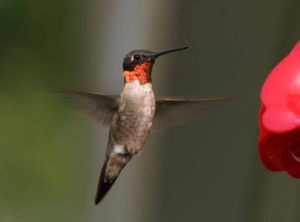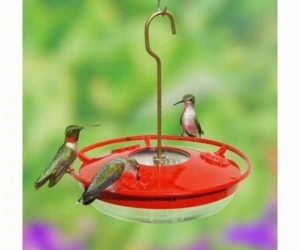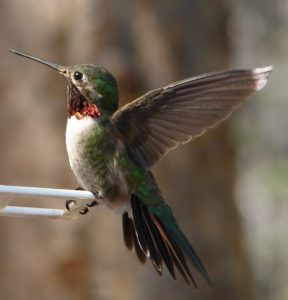by Teacher Peter Manzelmann, FSMH Outdoor Education Teacher
 The ruby-throated hummingbirds are almost here. When I checked the website www.hummingbirds.net and looked at the migration map, these little hummers have reached Maryland and will be here soon. For those of us who love watching these amazing birds during the course of the summer, get your feeders ready. These bitsy-sized birds (weighing 3 grams and can be sent by mail with a one ounce stamp – 49 cents) have traveled all the way from southern Mexico and Central America. If they didn’t follow the land route (Mexico and along Texas coast), then they flew 600 miles non-stop over the Gulf of Mexico just hovering 25 ft. over the water! They are hungry and moving north as the pollinating, nectar-filled flowers come to bloom. These hummingbirds will arrive in the next two weeks. Traditionally they arrive in Cape May County as early as April 4th coinciding with the blooming of Flowering Quince and azaleas.
The ruby-throated hummingbirds are almost here. When I checked the website www.hummingbirds.net and looked at the migration map, these little hummers have reached Maryland and will be here soon. For those of us who love watching these amazing birds during the course of the summer, get your feeders ready. These bitsy-sized birds (weighing 3 grams and can be sent by mail with a one ounce stamp – 49 cents) have traveled all the way from southern Mexico and Central America. If they didn’t follow the land route (Mexico and along Texas coast), then they flew 600 miles non-stop over the Gulf of Mexico just hovering 25 ft. over the water! They are hungry and moving north as the pollinating, nectar-filled flowers come to bloom. These hummingbirds will arrive in the next two weeks. Traditionally they arrive in Cape May County as early as April 4th coinciding with the blooming of Flowering Quince and azaleas.
Feeding these hummingbirds is easy but you have to make a commitment to maintain the feeders all summer long! My favorite feeder is the mini HummZinger 8 ounce (by Aspects, Inc.) and is easily ordered from Amazon or by supporting the Cape May Bird Observatory in Cape May (Northwood Center). I’ll put up two or three feeders around the yard making sure they are close to cover where the birds can perch and hide. The proper feeder solution is one part sugar and four parts water. Too much sugar can lead to liver damage and red dye is unnecessary. It is important to replace and clean the feeders every few days, especially when it is hotter because the sugar will ferment in the summer sun! Why more than one feeder? The males are very greedy and will dominate a single feeder. This will also encourage them to nest nearby if you have reliable feeders. Keep your feeders up late into November because you might attract a rare western hummingbird that has strayed. More importantly, a hummingbird feeder is not enough to attract hummingbirds. Planting native perennials and flowering trees, shrubs, and vines will attract hummingbirds and butterflies.
 Ruby-throated hummingbirds arrive first. The females arrive a week later. During courtship the male flies back and forth over the female as if on a pendulum swing. After mating, the female does everything else – builds the nest, incubates the eggs, and feeds the young. She makes a nest of silky plant fibers and the fluff of dandelion seeds, covers the nest with lichen, and holds it together with spider web. Amazingly, the female will find a spider web, wind the web around her bill, then unwind the spider web thread around the nest to secure it to the tree branch. An old nest is often occupied for several seasons and remodeled each year. They tend to lay two eggs between May 23 and August 10 and they are no bigger than kernels of puffed rice. The eggs are incubated for 11-14 days and young fledge 14 to 28 days after hatching. The young are fed by regurgitation from the mothers! What do they eat? Nectar, soft-bodied insects that feed on flowers, small flowers, and sap of trees due to Yellow-bellied Sapsuckers.
Ruby-throated hummingbirds arrive first. The females arrive a week later. During courtship the male flies back and forth over the female as if on a pendulum swing. After mating, the female does everything else – builds the nest, incubates the eggs, and feeds the young. She makes a nest of silky plant fibers and the fluff of dandelion seeds, covers the nest with lichen, and holds it together with spider web. Amazingly, the female will find a spider web, wind the web around her bill, then unwind the spider web thread around the nest to secure it to the tree branch. An old nest is often occupied for several seasons and remodeled each year. They tend to lay two eggs between May 23 and August 10 and they are no bigger than kernels of puffed rice. The eggs are incubated for 11-14 days and young fledge 14 to 28 days after hatching. The young are fed by regurgitation from the mothers! What do they eat? Nectar, soft-bodied insects that feed on flowers, small flowers, and sap of trees due to Yellow-bellied Sapsuckers.
If that is not enough about these really “cool” creatures, here is a bit more. They beat their wings 55/second while hovering, 61/ while moving backwards, 75/second while moving forward, and 200/second during display dive. The eastern United States has only one species (the ruby-throated), but five western hummers have all occurred occasionally here in late fall and winter. The western U.S. has about 13 hummers that breed there. Why don’t our ruby-throated hummers stay in their wintering grounds? I am sure there are plenty of flowering plants in the tropics. Answer: The ruby-throated hummingbird is smaller and is overpowered by the many larger hummers in the tropics. It is the best option to pick up their gear and head north as the season changes and flowering plants emerge.
 Listen to this! Enemies of these sweet little nectar eaters – some have been caught in spider webs. One was observed eaten by a bass that jumped out of the water and swallowed the bird. One was found in the stomach of a small falcon called a merlin. There have been several instances of frogs capturing and swallowing hummingbirds, even Preying Matis stalk them at feeders out west, and sadly outdoor cats take their toll to on hummingbirds.
Listen to this! Enemies of these sweet little nectar eaters – some have been caught in spider webs. One was observed eaten by a bass that jumped out of the water and swallowed the bird. One was found in the stomach of a small falcon called a merlin. There have been several instances of frogs capturing and swallowing hummingbirds, even Preying Matis stalk them at feeders out west, and sadly outdoor cats take their toll to on hummingbirds.
So there it is, the highlights of the magnificent ruby-throated hummingbird. Enjoy them and let me know how they have zipped and zoomed around your backyard.



Follow and Contact Us